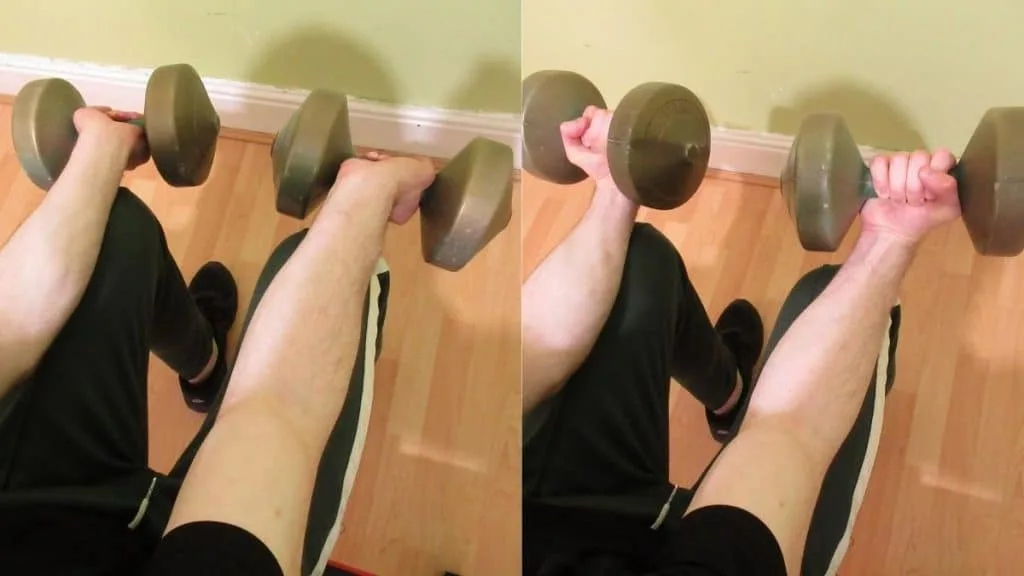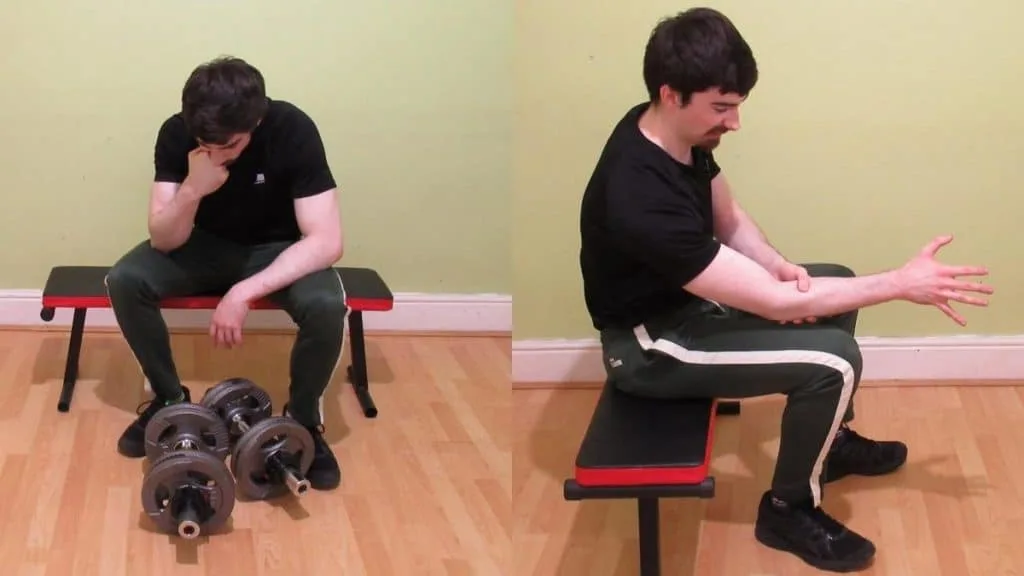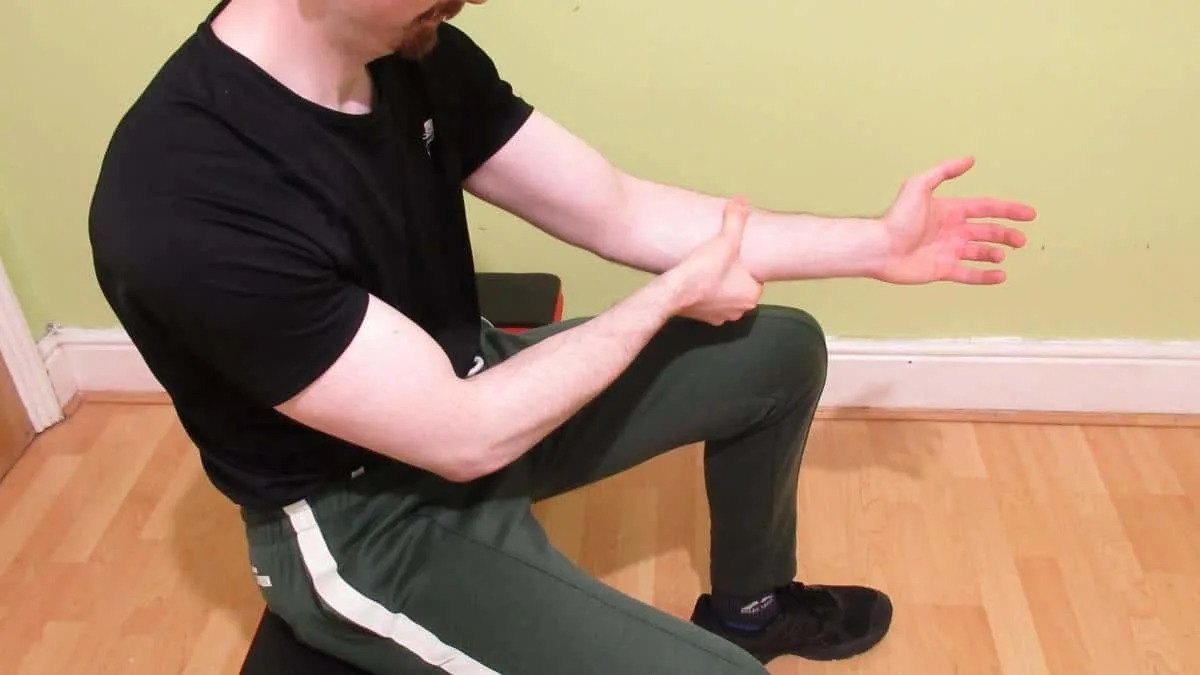The muscles of the forearm are complex and numerous. So diagnosing the source of the pain can be an issue. Other conditions like forearm splints and forearm pain from typing can cause similar pain to that brought on by fibromyalgia.
Unfortunately, there’s no known cure for fibromyalgia forearm pain. Also, as mentioned, it’s a hard condition to diagnose because doctors have to first rule out many other causes before they can confidently say that fibromyalgia is the source of your forearm pain.
So in this guide, I’m going to suggest some lifestyle changes and exercises that might reduce your discomfort. If your doctor thinks that these interventions are safe for you, then I recommend giving them a try for at least a few weeks. [1] Best of all, they’re completely natural.
1. Perform a regular stretching routine

If you have tight forearms or forearm cramping, then performing regular forearm stretches can help ease the problem. So before you cite fibromyalgia as the source of your forearm pain, it’s worth trying some simple stretches to see if they ease or eradicate your symptoms.
Here’s one that you can do now.
- Stand up straight or sit upright in a chair.
- Put your arms out in front of you and fully lock your elbows.
- Then, extend the wrist of one hand so that your palm is facing forward.
- Now, with your other hand, gently pull the working hand backward to increase the intensity of the stretch.
- Hold it for 10-30 seconds and then repeat the exercise for your other arm.
See also: myofascial release for the forearm
2. Check your exercise technique

I realize that some people who have fibromyalgia don’t perform resistance training because of the often debilitating effects of the condition. However, joint pain, as I’ve experienced too many times, is a common side effect of lifting weights.
For example, bodybuilders often experience forearm pain when curling because they have their lower arms in an unnatural supinated position for extended periods of time.
Likewise, you can experience pull up forearm pain if you use an unnaturally wide or narrow grip, which stresses your arms more than your back.
3. Manage your stress better

Stress doesn’t get talked about enough in the fitness world.
And even though I don’t personally suffer from fibromyalgia, I have experienced strikingly similar whole body aching after particularly nasty bouts of stress.
Exercise is a great way to keep your stress low, but it’s important that you don’t overdo it. Getting just enough exercise will help you to maintain a healthy weight, sleep better, and improve your mood. But in excess, it’ll flip the script and have the opposite effects—impaired weight loss, poor sleep, bad mood.
Another good stress-busting solution is spending time with your family, friends, and In nature. Avoid isolating yourself and living your life on technology because this deprives you of the social contact that’s so necessary to lead a happy life.
4. Try physical therapy

You can improve your fibromyalgia forearm pain and brachioradialis pain by performing rehabilitation exercises under the guidance of a physical therapist. This rehab will strengthen your forearms and make them more resistant to everyday stressors, which ultimately means that they’ll be more adept at resisting pain.
If you get forearm pain from gaming or spend a lot of time on the computer, here’s an excellent equipment-free exercise that you can try.
Also, consider trying these forearm rehabilitation exercises for more variation and to work different parts of your lower arms.
- Sit upright in a chair.
- Place your hands, palms down, out in front of you.
- Turn your hands to a palms-up position by rotating your wrists. Aim to keep your shoulders and upper arms as still as possible.
- Return your hands to their original position by once again rotating your wrists. This is one rep.
- Repeat for sets of 10 reps.
Related pain posts
5. Eat healthier foods

If you have fibromyalgia-induced forearm pain, then you can eat a healthier diet to make your immune system and body in general more resistant to illnesses and disorders. [2]
Of course, fruits and vegetables offer plenty of fiber, vitamins, and minerals, but don’t forget the foods that give you strength. Eating quality meat, fish, and dairy will help you to build a body that’s not only healthy but also strong enough to fight against diseases.
Whatever your dietary preferences, though, it’s crucial to limit your intake of junk food (better yet, avoid it altogether) because it increases inflammation, which in turn worsens existing joint pain and makes it harder to recover from exercise and everyday tasks.
The verdict on fibromyalgia and forearm pain

All forearm strains are bad, but fibromyalgia can be particularly distressing because, as I said, there’s no known cure. [3] Hopefully, these natural tips will give you something to suggest to your doctor and physical therapist. If they give you the green light, then you can start making some lifestyle changes and then observe the results.
Just make sure to stick at them. Unlike some medicines, lifestyle changes can take days and weeks to have a strong effect. So don’t let the discomfort crush your determination to improve your situation!
References
- Bruce, D. F. (2008, May 29). What Is Fibromyalgia? WebMD. https://www.webmd.com/fibromyalgia/guide/what-is-fibromyalgia
- NHS website. (2020, August 11). Fibromyalgia. Nhs.Uk. https://www.nhs.uk/conditions/fibromyalgia/
- Fibromyalgia – Symptoms and causes. (2020, October 7). Mayo Clinic. https://www.mayoclinic.org/diseases-conditions/fibromyalgia/symptoms-causes/syc-20354780
- Mayo Clinic. (2013, November 7). Fibromyalgia Overview [Video]. YouTube. https://www.youtube.com/watch?v=4ZMCO4tEuYw

